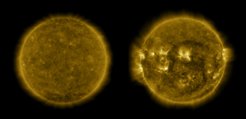Solar cycle 25 has begun
Since December 2019, solar activity has been on the up. This is consistent with predictions, to which MPS researchers contributed.
In the past one and a half years, the Sun has been rather dull: hardly a sunspot covered its surface, hardly a solar flare hurled radiation and particles into space. As observational data now show, for the last nine months solar activity has been slowly picking up again. Already in December 2019, our star passed its activity minimum, an event which occurs approximately every eleven years. This confirms predictions made by the Solar Cycle 25 Prediction Panel, an international panel of experts organized by NASA and NOAA (National Oceanic and Atmospheric Administration), in March last year. The panel, whose members include Dr. Robert Cameron from the Max Planck Institute for Solar System Research (MPS) in Germany, expects the Sun to be as tame in the now beginning solar cycle 25 as it has been in the previous eleven years.

For more than 30 years, NASA and NOAA regularly invite international experts to predict the solar activity of the next few years. This is not an easy task, since our star’s behavior is characterized by a peculiar interplay of reliability and capriciousness. Phases of high and low solar activity alternate in an astonishingly regular rhythm: approximately eleven years lie between two activity minima. At the same time, some properties of solar cycles such as their strength and exact duration can vary and do not seem to obey a long-term rule.
The most recent solar cycle prediction from March 2019 has now passed its first test and correctly foreseen the start of the next cycle, the 25th since the beginning of reliable solar observations, as NASA and NOAA announce today. The Solar Cycle 25 Prediction Panel had located this point in time between November 2019 and October 2020. Measurements from research satellites in recent months now show that solar activity has indeed been increasing again since December 2019.

Determining the behavior of our star in advance is not only of scientific interest. "In phases of high activity, violent eruptions of particles and radiation from the Sun can also effect Earth," says Dr. Robert Cameron from MPS, who contributed to the predictions. In the worst case, this can cause damage to technical systems such as satellites or endanger astronauts.
The new solar cycle should give little cause for concern in this respect. The Prediction Panel predicts it to be similar to its rather feeble predecessor. The strength of solar cycles has been showing a clear downward trend since the 1980s. "As it appears, the current period of low solar activity, compared to the strong cycles over most of the last 50 years, will continue over the next eleven years," says Cameron. The next, rather weak solar maximum should occur between November 2024 and March 2026.
Although forecasts of earlier solar cycles were in some cases noticeably off track, Robert Cameron is convinced that the Sun’s behavior can be determined in advance - but only a few years beforehand. New findings in solar research have made this possible, he believes.

Important clues are provided by local magnetic structures that appeared years earlier on the Sun’s visible surface. These so-called bipolar regions consist of closely adjacent areas of opposite magnetic polarity and are often accompanied by sunspots. Like on a kind of solar conveyor belt, over the course of several years huge meridional plasma flows carry these local magnetic fields from near the equator to the solar poles - thus building up the global solar magnetic field that will shape the next solar cycle. At the poles, the plasma descends into the solar interior where it progresses back to the equator. "Each revolution takes about eleven years and is the physical basis of the solar cycle," says Cameron.
For predictions of solar activity, it is crucial, on the one hand, to observe precisely and continuously the number and distribution of bipolar regions that form on the surface of the Sun years earlier. Satellites such as NASA’s Solar Dynamics Observatory have been providing the necessary data for several years now. On the other hand, helioseismology, a still young sub-discipline of solar research, makes it possible to visualize processes in the interior of the Sun and thus determine the exact speed of the plasma flows constituting the solar conveyor belt.
"With these methods, we can anticipate several years in advance how the Sun will behave in the next solar cycle," says Cameron. Predictions, however, that go beyond one solar cycle are by principle not possible.














